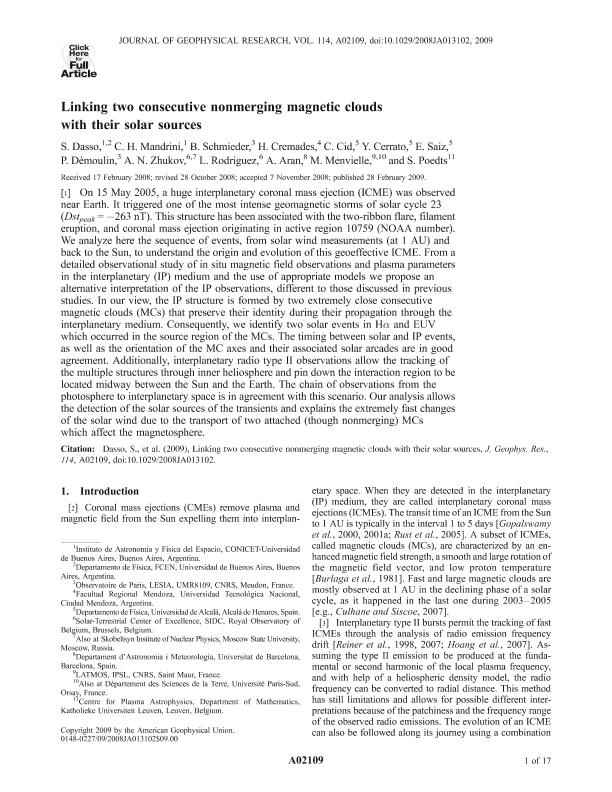Mostrar el registro sencillo del ítem
dc.contributor.author
Dasso, Sergio Ricardo

dc.contributor.author
Mandrini, Cristina Hemilse

dc.contributor.author
Schmieder, B.
dc.contributor.author
Cremades, H.
dc.contributor.author
Cid, C.
dc.contributor.author
Cerrato, Y.
dc.contributor.author
Saiz, E.
dc.contributor.author
Démoulin, Pascal

dc.contributor.author
Zhukov, A. N.
dc.contributor.author
Rodriguez, L.
dc.contributor.author
Aran, A.
dc.contributor.author
Menvielle, M.
dc.contributor.author
Poedts, S.
dc.date.available
2017-09-20T20:10:37Z
dc.date.issued
2009-12
dc.identifier.citation
Dasso, Sergio Ricardo; Mandrini, Cristina Hemilse; Schmieder, B.; Cremades, H.; Cid, C.; et al.; Linking two consecutive non-merging magnetic clouds with their solar sources; American Geophysical Union; Journal of Geophysical Research; 114; A02109; 12-2009; 1-17
dc.identifier.issn
0148-0227
dc.identifier.uri
http://hdl.handle.net/11336/24757
dc.description.abstract
On 15 May 2005, a huge interplanetary coronal mass ejection (ICME) was observed near Earth. It triggered one of the most intense geomagnetic storms of solar cycle 23 (Dstpeak = −263 nT). This structure has been associated with the two-ribbon flare, filament eruption, and coronal mass ejection originating in active region 10759 (NOAA number). We analyze here the sequence of events, from solar wind measurements (at 1 AU) and back to the Sun, to understand the origin and evolution of this geoeffective ICME. From a detailed observational study of in situ magnetic field observations and plasma parameters in the interplanetary (IP) medium and the use of appropriate models we propose an alternative interpretation of the IP observations, different to those discussed in previous studies. In our view, the IP structure is formed by two extremely close consecutive magnetic clouds (MCs) that preserve their identity during their propagation through the interplanetary medium. Consequently, we identify two solar events in Hα and EUV which occurred in the source region of the MCs. The timing between solar and IP events, as well as the orientation of the MC axes and their associated solar arcades are in good agreement. Additionally, interplanetary radio type II observations allow the tracking of the multiple structures through inner heliosphere and pin down the interaction region to be located midway between the Sun and the Earth. The chain of observations from the photosphere to interplanetary space is in agreement with this scenario. Our analysis allows the detection of the solar sources of the transients and explains the extremely fast changes of the solar wind due to the transport of two attached (though nonmerging) MCs which affect the magnetosphere.
dc.format
application/pdf
dc.language.iso
eng
dc.publisher
American Geophysical Union

dc.rights
info:eu-repo/semantics/openAccess
dc.rights.uri
https://creativecommons.org/licenses/by-nc-sa/2.5/ar/
dc.subject
Interplanetary Physics: Ejecta, Driver Gases And Magnetic Clouds
dc.subject
Interplanetary Physics: Interplanetary Magnetic Fields
dc.subject
Interplanetary Physics: Coronal Mass Ejections
dc.subject
Solar Physics: Astrophysics, And Astronomy: Coronal Mass Ejections
dc.subject
Solar Physics: Astrophysics, And Astronomy: Radio Emissions
dc.subject.classification
Astronomía

dc.subject.classification
Ciencias Físicas

dc.subject.classification
CIENCIAS NATURALES Y EXACTAS

dc.title
Linking two consecutive non-merging magnetic clouds with their solar sources
dc.type
info:eu-repo/semantics/article
dc.type
info:ar-repo/semantics/artículo
dc.type
info:eu-repo/semantics/publishedVersion
dc.date.updated
2017-09-20T13:40:22Z
dc.journal.volume
114
dc.journal.number
A02109
dc.journal.pagination
1-17
dc.journal.pais
Estados Unidos

dc.journal.ciudad
Nueva York
dc.description.fil
Fil: Dasso, Sergio Ricardo. Consejo Nacional de Investigaciónes Científicas y Técnicas. Oficina de Coordinación Administrativa Ciudad Universitaria. Instituto de Astronomía y Física del Espacio. - Universidad de Buenos Aires. Facultad de Ciencias Exactas y Naturales. Instituto de Astronomía y Física del Espacio; Argentina
dc.description.fil
Fil: Mandrini, Cristina Hemilse. Consejo Nacional de Investigaciónes Científicas y Técnicas. Oficina de Coordinación Administrativa Ciudad Universitaria. Instituto de Astronomía y Física del Espacio. - Universidad de Buenos Aires. Facultad de Ciencias Exactas y Naturales. Instituto de Astronomía y Física del Espacio; Argentina
dc.description.fil
Fil: Schmieder, B.. Centre National de la Recherche Scientifique. Observatoire de Paris; Francia
dc.description.fil
Fil: Cremades, H.. Universidad Tecnológica Nacional; Argentina
dc.description.fil
Fil: Cid, C.. Universidad de Alcalá; España
dc.description.fil
Fil: Cerrato, Y.. Universidad de Alcalá; España
dc.description.fil
Fil: Saiz, E.. Universidad de Alcalá; España
dc.description.fil
Fil: Démoulin, Pascal. Centre National de la Recherche Scientifique. Observatoire de Paris; Francia
dc.description.fil
Fil: Zhukov, A. N.. Royal Observatory of Belgium; Bélgica
dc.description.fil
Fil: Rodriguez, L.. Royal Observatory of Belgium; Bélgica
dc.description.fil
Fil: Aran, A.. Universidad de Barcelona; España
dc.description.fil
Fil: Menvielle, M.. Universite Paris Sud; Francia
dc.description.fil
Fil: Poedts, S.. Katholikie Universiteit Leuven; Bélgica
dc.journal.title
Journal of Geophysical Research

dc.relation.alternativeid
info:eu-repo/semantics/altIdentifier/doi/http://dx.doi.org/10.1029/2008JA013102
dc.relation.alternativeid
info:eu-repo/semantics/altIdentifier/url/http://onlinelibrary.wiley.com/doi/10.1029/2008JA013102/abstract
Archivos asociados
